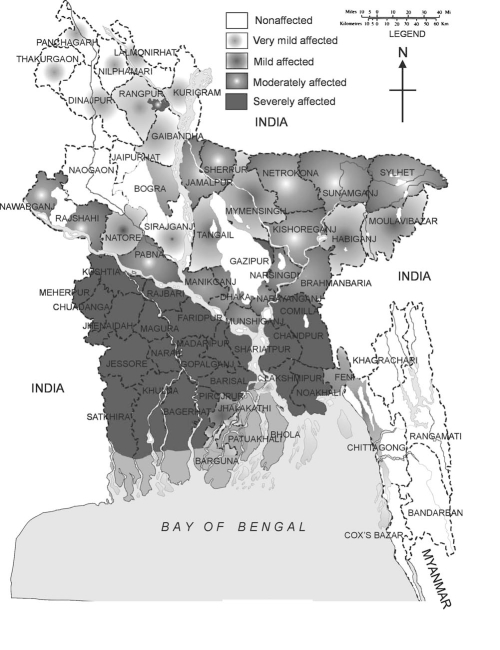GROUNDWATER ARSENIC CONTAMINATION IN BANGLADESH
Groundwater arsenic contamination and sufferings of people in Bangladesh surfaced in 1995. At that time,
there was information about three affected villages in two police stations of two districts (Narayanganj
and Faridpur). During the last 7 yr, a tremendous amount of survey work was done to determine the
magnitude of the arsenic calamity in Bangladesh.
Present survey reports indicate that 2000 villages in 178 police stations of 50 districts out of total 64 districts
in Bangladesh, groundwater contains arsenic above 50 mg/L. Bangladesh comprises four existing
geo-morphological regions:
1) Deltaic region (including coastal region);
2) Flood Plain;
3) Tableland;
4) Hill Tract.
Of these four regions, Hill Tract is free of arsenic contamination. Most of the Tableland
region is also contamination-free (except Flood Plain deposition on the eroded surface of Tableland).
The highly arsenic-contaminated areas of Bangladesh are Deltaic region followed by Flood Plain (Fig. 4).

Fig. 4 Map shows the status of arsenic in groundwater in all 64 districts of Bangladesh and in four geo-morphological regions..
Huge arsenic-free groundwater aquifers remain in selected areas of Bangladesh. Arsenic-contaminated
areas of Bangladesh belong to arsenic-bearing Holocene sediments. BangladeshÆs arsenic calamity is considered
the worst in the world. The World Bank and World Health Organization (WHO) described the
magnitude of arsenic contamination in Bangladesh.
The World BankÆs local chief stated that tens of millions of people are at risk from health effects,
and that 43,000 of the 68,000 villages are presently at risk or could be at risk in future. According to
the prediction of WHO, within a few years, death across much of southern Bangladesh (1 in 10 adults)
could be from cancers triggered by arsenic. The area and population of Bangladesh are 148,393km2 and
120 million, respectively. Thirty-four thousand hand tubewell water samples from 64 districts in
Bangladesh have been analyzed and 56% contained arsenic above 10 mg/L, that the WHO recommended
level of arsenic in drinking water with 37% contained more than 50 mg/L, the WHO maximum permissible
limit. Maximum concentration of arsenic found in groundwater of Bangladesh was 4730 mg/L.
Overall result shows only 25% and 37% of hand tubewells contain arsenic above 50 mg/L in arsenic-affected
areas of West Bengal and Bangladesh, respectively, but there are many villages in West Bengal and
Bangladesh where 80¢90% of hand tubewells contain arsenic above 50 mg/L. It has been estimated that at
the present time, more than 25 million people in Bangladesh are drinking arsenic-contaminated water
above 50 mg/L, and 51 million people are drinking water above 10 mg/L. Analyses of more than 9900
biological samples from arsenic-affected villages of Bangladesh indicate that 95% of samples contain
arsenic above normal level. So far in a preliminary survey, over 10,000 people have been identified with
arsenical skin lesions from 222 out of 253 villages surveyed for patients.
